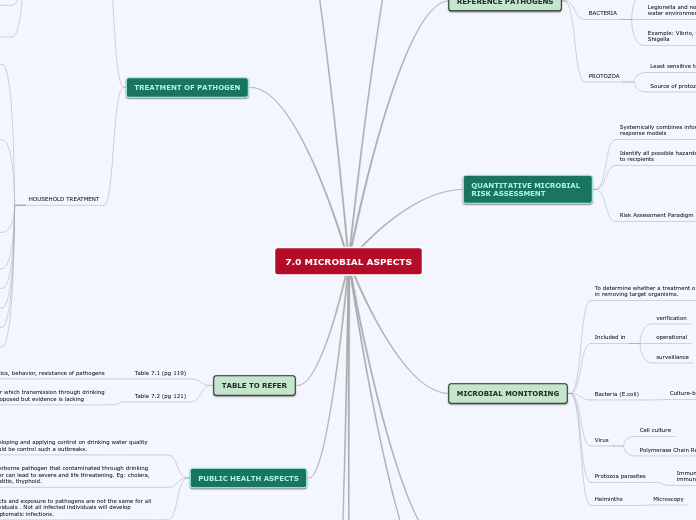7.0 MICROBIAL ASPECTS
ROUTE OF TRANSMISSION
Inhalation of water droplets
Contact with water (dermal)
Ingestion of the eggs in food
contaminated with faeces or
faecally contaminated
Patients undergoing immunosuppressive
therapy or those with acquired
immunodeficiency syndrome (AIDS)
REFERENCE PATHOGENS
VIRUSES
Smallest pathogen and difficult to remove by physical process (filtration)
Can persist in a long period inn water
Example: Rotaviruses, enteroviruses, and noroviruses
BACTERIA
Most sensitive to inactivation by disinfection
Legionella and non-tuberculous mycobacteria can grow in water environment
Example: Vibrio, Campylobacter, E.coli O157, Salmonella and Shigella
PROTOZOA
Least sensitive to inactivation by chemical disinfection
Source of protozoa: Cryptospotidium and Balantidium
QUANTITATIVE MICROBIAL RISK ASSESSMENT
Systemically combines information on exposure and dose-response models
Identify all possible hazards and their pathways from sources to recipients
Risk Assessment Paradigm For Pathogen Health Risks
Exposure Assessment: Estimation of number of pathogen that is exposed to an individual through ingestion
Dose-Response Assessment: To derive the probability of an adverse effect following exposure to one or more pathogenic organisms
Risk Characterization: Data collection on exposure, dose-response and incidence and severity of disease
MICROBIAL MONITORING
To determine whether a treatment or other process is effective in removing target organisms.
Included in
verification
operational
surveillance
Bacteria (E.coli)
Culture-based method
Broth cultures
Solid media
Virus
Cell culture
Polymerase Chain Reaction (PCR)
Protozoa parasites
Immunomagnetic separation in combination with immunofluorescence microscopy
Helminths
Microscopy
METHODS OF DETECTION OF FAECAL INDICATOR ORGANISMS
Analysis for faecal indicator organisms provides a sensitive, although not the most rapid, indication of pollution of drinking-water supplies.
The standardization of methods and of laboratory procedures is of great importance if criteria for the microbial quality of water are to be uniform in different laboratories and internationally.
IDENTIFYING LOCAL ACTIONS IN RESPONSE TO MICROBIAL WATER QUALITY PROBLEMS AND EMERGENCIES
Boil water advisories
Actions following an incident
PERSISTANCE AND GROWTH IN WATER
pathogen with low persistence are more likely to be spread by person to person contact or poor personal hygiene.
persistence is affected by several factors such as temperature.
high amount of biodegradable organic carbon together with warm water can permit growth of waterborne pathogen.
OCCURANCE
To determine the pathogen concentration in source water
To provide treatment so that ensure health within water safety plan
The concentration of pathogen in raw water can be estimated from concentration of pathogens in waste water
Faecel indicator bacteria, such as E.Coli always present at high concentration in waste water
Discharge water is diluted in receiving surface water leading to reduce pathogen number with the dilution factor
TREATMENT OF PATHOGEN
CENTRAL TREATMENT
Validation is important in ensuring that treatment will achieve the desired goals
Water treatment required to remove or destroy pathogenic microorganism
For example : poor quality surface water require multiple treatments stages.
coagulation
flocculation
sendimentation
filtration
disinfection
The case that efficacy for microbial reduction differ among the microbial groups so different treatment process are needed.
There are positive and negative interactions occur between multiple steps and these can affect the overall of water quality.
HOUSEHOLD TREATMENT
Chemical disinfection
Free chlorine disinfection
Membrane, porous ceramic or composite filters
Porous ceramic and carbon block filtration
Membrane filtration
Microfiltration
Nanofiltration
Ultrafiltration
Reverse osmosis
Fiber and fabric filtration
Granular media filter
Rapid granular, diatomaceous earth, biomass and fossil fuel - based filter
Household-level intermittently operated slow sand fi ltration
Solar disinfection
Solar UV radiation + thermal effects
UV light technologies using lamps
UV irradiation
Thermal (heat) technologies
Boiling
Coagulation, precipitation and / or sedimentation
Simple sedimentation
Combination (multiple-barrier) treatment approaches
Flocculation plus disinfection systems
e.g. commercial powder sachets or tablets
TABLE TO REFER
Table 7.1 (pg 119)
Characteristics, behavior, resistance of pathogens
Table 7.2 (pg 121)
Microorganisms for which transmission through drinking
water has been proposed but evidence is lacking
PUBLIC HEALTH ASPECTS
developing and applying control on drinking water quality should be control such a outbreaks.
waterborne pathogen that contaminated through drinking water can lead to severe and life threatening. Eg: cholera, hepatitis, thyphoid.
effects and exposure to pathogens are not the same for all individuals . Not all infected individuals will develop symptomatic infections.
EMERGING ISSUES
global changes, human development, population growth and climate change influence water disease risk
zoonatic pathogen make up 75% of the emerging pathogens.
zoonatic pathogen pose the greatest challenge to ensure the safety of drinking water and ambient water
